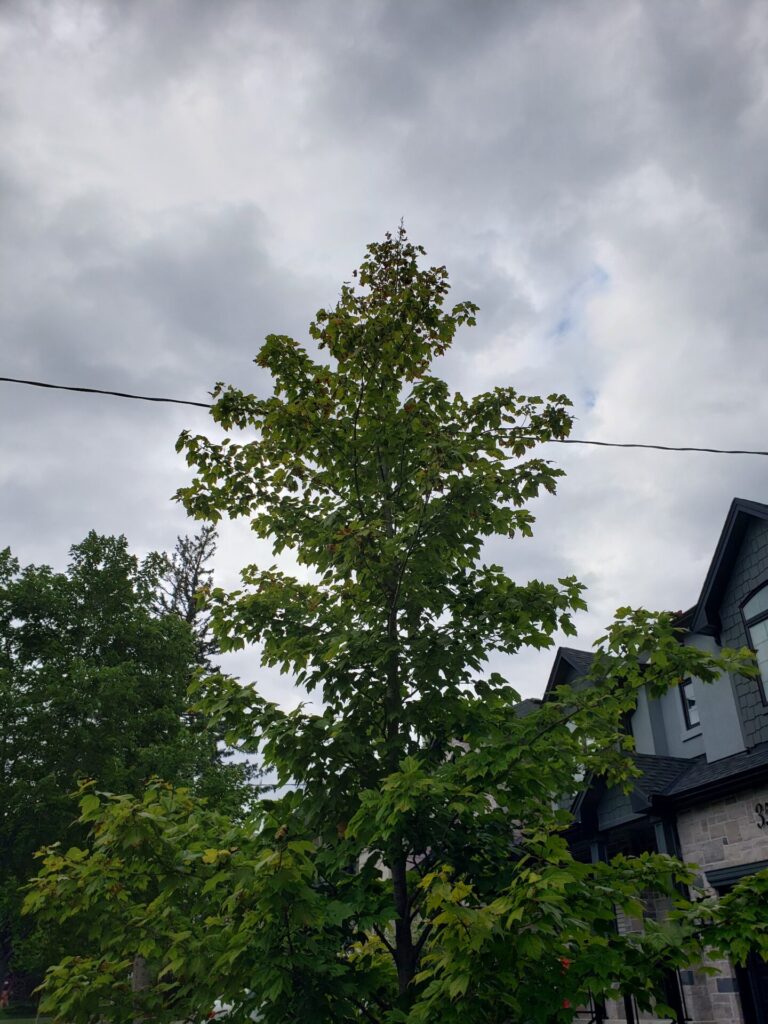
I have a city tree (planted 4 years ago(?)) that had had a fungal infection for the last three years. Year by year the tree looks worse.
How can I get the city to replace with an appropriate tree. I cannot keep waiting for the tree to die as I am not sure which will go firt…the tree or me.
I would be willing if permitted to plant a new and appropriate tree to replace this very sick tree (about 20feet tall).
Dear Gardener, thank you for asking this question that seems relevant to many of the maple trees that beautify the streets of Toronto. I have been noticing the spread of this fungus with great alarm this year. It seems to be affecting many different species of maple trees. The leaves are first covered in a white powder, and then curl up and turn brown and fall. Our glorious maples are looking dreadful.
The City of Toronto will allow you to hire (and will pay for) a private arborist to treat diseased trees once you have submitted a form and they have approved of the application. But the City will not approve of the tree being cut down. (The one exception, is that the City will replace trees that are commemorative trees if the tree does not thrive within five years of of the original planting date. However, you did not say that your tree was a commemorative tree.)
From the diseases that are listed on the City’s “Threats to Trees: Diseases”, powdery mildew seems the closest to what is affecting our maples. Powdery mildew can be a range of fungal diseases that affects different species of trees, and each is species-specific. The most common of the fungi is Erysiphe cichoacearum. However, the New York Botanical Gardens says that Phyllactinia guttata is the fungus that afflicts maples, and it can pass the infection to other trees including birch, horse chestnut, hornbeam and dogwood.
However, it may also be anthracnose, and Toronto Master Gardeners have written about this disease affecting maples in previous years. Thirdly, the culprit may be Black Spot, caused by the fungus Rhytisma; in this case most likely Rhytisma acerinum. Toronto Master Gardeners have also written about this fungus affecting maple trees.
However, the bottom line, is that the City says that these fungal diseases are not lethal, only aesthetically unpleasing, and that the tree will recover. Trees are not removed if they get a fungus.
Powdery mildew occurs when the humidity goes over 90%, which it has in the last couple of weeks in Toronto (late June to mid-July), but usually only appears at the end of the summer. Anthracnose affects the tree in cool, wet weather, which is what our spring was like. Black Spot also likes cool, damp weather. With our very irregular spring and summer that has fluctuated from cold to very hot, and very dry to very wet, the conditions for fungi to flourish is perfect.
Norway Maples, Acer platanoides, are the most susceptible of the maples to all fungal disease because of its dense canopy, its height which prevents easy treatment, but also because it is not native, and it is invading our ravines. That is why the City of Toronto is no longer planting Norway Maples.
The suggestion for how to reduce the probability of your maple tree getting a fungus next year, is to collect the leaves in the Fall and put them out for the city compost since our home composters are not hot enough to kill the fungus. The Treehugger website has some interest details about the lifecycle of the fungus.
If you would like to have an expert take a look at your tree, may I suggest that you contact Landscape Ontario to identify a qualified arborist who can come to your home for a professional diagnosis and to offer you advice. They may suggest that you thin out your tree to improve air circulation.
I am afraid that it looks as though we will be living with these fungal disease for many years now, especially as the temperature in summer heats up due to global warming. Sorry that I do not have better news for you.

